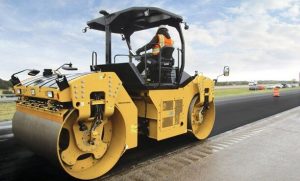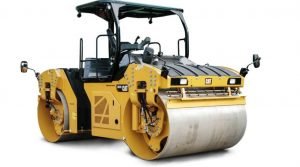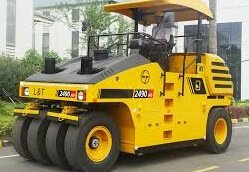Road Roller: its 7 Types, Analysis, and Advantages
A road roller is used to compact soil, concrete, gravel, or asphalt in the construction of foundations and roads and is a compactor type engineering vehicle. In landfills and agriculture, road roller is also used.
The rolling procedure makes sure that foundations are compacted thoroughly and the materials are compact and do not come loose and in the construction industry road rollers are iconic.

There are different parts in the road roller such as diesel engines, canopy to protect the driver, a drum which can be a vibratory smooth drum or a static smooth drum, a compaction meter to measure the level of compaction and a water system, and tires.
Analysis of Use of Road Roller:
They started as simple stone cylinders being pulled by people to flatten the earth a bit in history and then as a means to flatten the earth, they made animals pull large stone cylinders or wooden planks. Then the rollers finally came into play when the age of metal came and in construction sites, this piece of heavy equipment is one of the most common machines to find. Mostly at the beginning stages when the foundation of the building is being built they are used.
The main use for road roller is to crush, knead or vibrate loose materials by applying direct pressure and most often used for road construction or for creating compact foundations for large areas. To compact loosely bound foundation materials rolling process is used.
To compress the surface being rolled or use mechanical advantage, road roller use the weight of the vehicle and by using a Padfoot drum roller initial compaction of the substrate on a road project is done. In landfill compaction, rollers are also used.
Types of Road Roller:
There are the following types of road roller as given below;
- Single Drum Roller
- Double Drum Roller
- Cylindrical Rollers
- Vibratory Roller
- Grid Rollers
- Pneumatic Rollers
- Sheepsfoot Rollers
Single Drum Roller:
This roller is a heavy-duty piece of machinery and the back has special tires while the front has a giant drum. To prevent most flats, these tires are sturdier and able, and when you work on construction sites and roads you need these heavy-duty tires.
The driver sits in the middle section in the single drum roller and this part of the road roller is known as cab which gives the driver a great view of the nearby area at a certain height.

Due to their smaller size, these rollers can work in tighter spaces and more specialized projects, and for buildings and paving highways or sidewalks they are great for creating foundations.
Double Drum Roller:
The double drum roller has one steel drum in the front and one in the back and the roller is moved by these drums. At the same time, a double drum roller can smooth objects in front of and behind the driver and these rollers operate best on flat services or ones with gradual grading.

These rollers are not recommended for anything specialized because they have very little traction.
Cylindrical Rollers:
These rollers have the traditional cylinder drum and are the most basic type of road roller and these are just single drum rollers or two drums depending on the design.
For consolidating stone or other similar materials into flat land this type of road roller is mostly used and when you use surface dressings to create an even smoother and flatter surface these rollers are believed to work best.
For small and private projects such as yard work, cylindrical rollers are mainly used and they are generally made of iron, stone, or concrete and are typically 1 meter in diameter.
Vibratory Roller:
The vibratory roller has an internal eccentric shaft that causes the wheel drums to vibrate and its vibratory function enhances its functionalities.
In applications with granular base layers these rollers are mainly used and some time in highway construction they are also used in laying asphalt. To create denser layers to add greater depth to the foundation the vibratory features help reduce the space between particles in the materials being compacted.

By using a vibratory roller can help keep the building’s structural integrity and the vibrations also cause the particles to lie closer together.
Grid Rollers:
These rollers have a network of steel bars that create a grid-like pattern on the steel drum and for more contact pressure the grid may also be ballasted with concrete blocks or steel attachments. These rollers are generally pulled or towed behind any heavy machine or a tractor.

With little kneading action on compaction work, the grid design on the cylinder drum produces a high contact pressure and on well-graded, coarse soils, weathered rocks and for sub-grade and sub-base road constructions, they are most suitable.
Pneumatic Rollers:
These rollers are ride-on roller with several rows of rubber tires on the front or rear end and throughout the width of the tires, the rubber tires provide an 80% coverage area and uniform pressure.

For pavements, they are typically used and can help smooth out and polish a project and for cold-laid bituminous or cold mixed pavements and layers of loose soil, they are also great.
Sheepsfoot Rollers:
These rollers are with many rectangular-shaped lugs and in road construction work, they are great for compacting soil and silty clay.

This type of road roller is used in any projects with wet clay or other fine-grained soils at great depths and by sheepsfoot rollers you can finish off areas compacted.
Advantages of Road Roller:
There are the following advantages of road roller such as;
- To provide a finish that is easy to the eyes and simply works out as intended, the road rollers are used.
- The road rollers are easy to use and to handle everything the project demands the road roller is suitable.
- The road rollers are powerful.
- They are safe.
Add a Comment
You must be logged in to post a comment.

nice